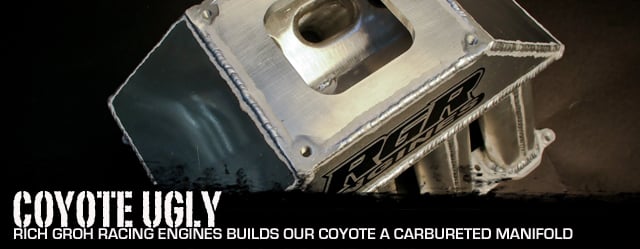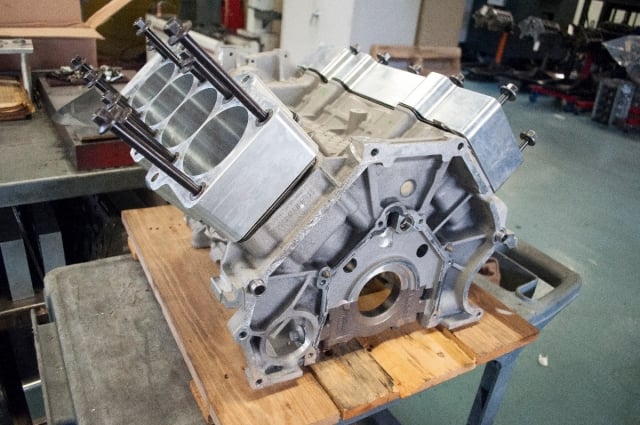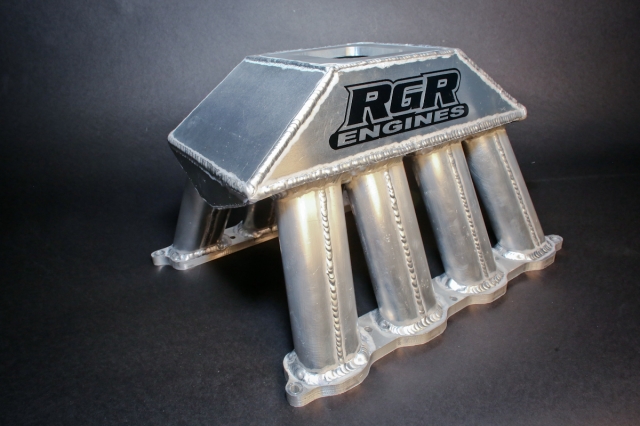We strive to be different. Simple head/cam/intake manifold technical articles have their place in automotive media, but we like to take on projects that stir up the masses and get them thinking, “What are these guys up to next?”
With that mantra in mind, Power Automedia Group Editor Mark Gearhart hatched a plan to build a carbureted Ford 5.0L Coyote engine. It’s not just any Coyote, though – this one will feature a 3.700-inch bore utilizing Livernois Motorsports‘ latest techniques in block sleeving and a host of other cool features. In fact, we just published an article on the Livernois process. Eventually, nitrous oxide will be employed to build even more power from the 11.2-11.5:1 compression, 8,500-plus-rpm screamer.
One struggle in replacing the Coyote’s factory fuel injection with a carburetor is the lack of a suitable intake manifold. All Coyote manifolds from Ford Racing are tailored towards fuel injection and constructed with composite polymer. Since the aftermarket doesn’t offer an off-the-shelf carb version, we are forced to go a different route in our pursuit of an old-school-meets-new-school Coyote.
To that end, we contacted Rich Groh at Rich Groh Racing Engines, the architect of the Project Wild E. Coyote’s engine (which you can read about here and here), to help design a manifold that will achieve our goals.
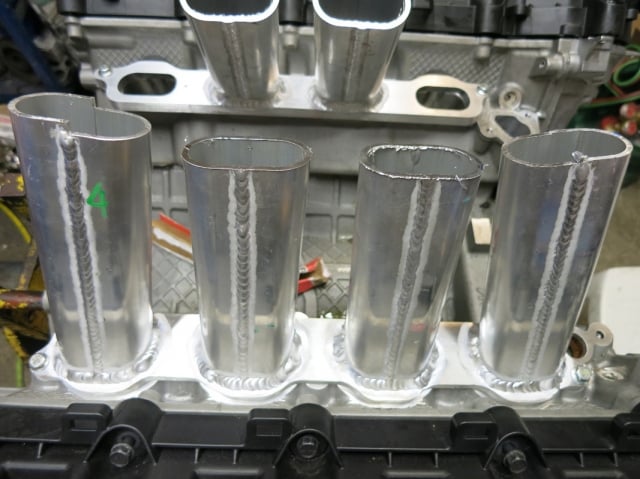
Plenum design was created using a computer simulation process to estimate the engine’s airflow requirements.
He devised a plan to fabricate a sheet-metal manifold that would achieve reach our power goals while still retaining street manners.
“When you design an intake manifold like this, there are a number of things you need to take into account. Intake runner length and intended rpm range are two of the most important. There are software formulas out there to help determine these parameters,” Groh explains. “That’s the nice thing about engine building; there are two things that are real definable – the intake and exhaust pipe length can be done through computer simulation and be pretty spot-on.”
Left: Flanges were mocked up with a cardboard template before Groh constructed them on a mill, by hand, from 6061-T6 half-inch plate stock. Middle: Who doesn't love aluminum TIG welding? Right: Each runner was spec'd out at six inches long with a gradual taper from entry point to the cylinder head flange.
Using those formulas, Groh determined the intake runners needed to be six inches long for this engine. Since the manifold is designed from scratch, rather than modifying an existing manifold, keeping the runner lengths equal is important to eliminate compromises. “When you have the freedom to design it straight and keep things simple, you can get it right the first time,” says Groh.
Rather than creating a CNC program to cut the machined 6061-T6 half-inch-thick flanges, Groh found it easier for this one-off manifold to mill aluminum stock from cardboard templates.
Plenum design is also critical. If it’s too small, the engine will starve for fuel and air.
“We’ve found that a minimum plenum size is important, but we really haven’t found a max. If you go a little too big it really doesn’t seem to hurt anything,” says Groh. “The plenum just becomes a mixture of air and fuel and the cylinders just draw it in. As long as the air/fuel mixture can get to each of the cylinders relatively equally, we’re in good shape.”
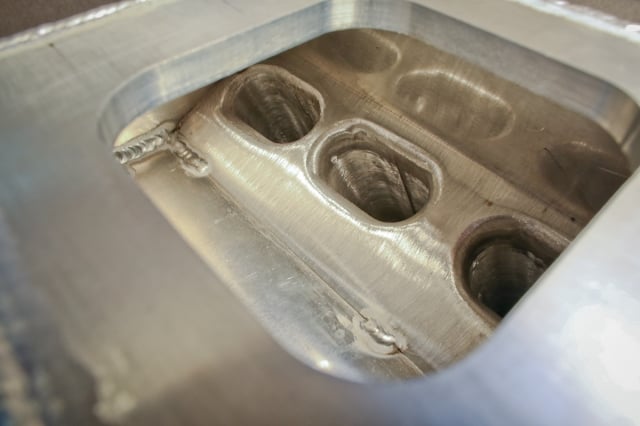
The inside of the plenum. Note how the plenum floor is tucked up tight to the runners to prevent fuel puddling. Each runner was mocked up by hand prior to final welding. Runners are created from extrusion stock that has been hand-modified to achieve the final dimensions.
Constructing intake manifolds isn’t as simple as Groh makes it seem, however. Keeping the plenum area open to allow the air and fuel a chance to mix “in the box” is vitally important. For example, it didn’t make sense to extend the runner length more towards the bottom of the carburetor.
“What happens there is that it’s a compromise. If you extend the runners more towards the bottom of the carburetor, you have to bend and twist them to get them there, and you start to have distribution problem in the runner,” says Groh.
“Let’s say we funnel the outside runners more towards the center of the plenum; the four inside runners (cylinders 2, 3, 6 and 7) would get all the love in the world since it would be a straight shot, but your outside runners would be affected negatively in terms of airflow,” continues Groh. “It’s the same issue that you see with cast-aluminum manifolds in supercharged and turbocharged applications; you see the distribution problem where the racers are burning up the center cylinders, because they get the most air, and the outer cylinders have the twists and turns – they don’t burn as easily because they don’t get as much air. I’m more a fan of getting the runners equal and getting the flow on those as good as you can, and letting the natural progression of air and fuel to find its way to those holes.”
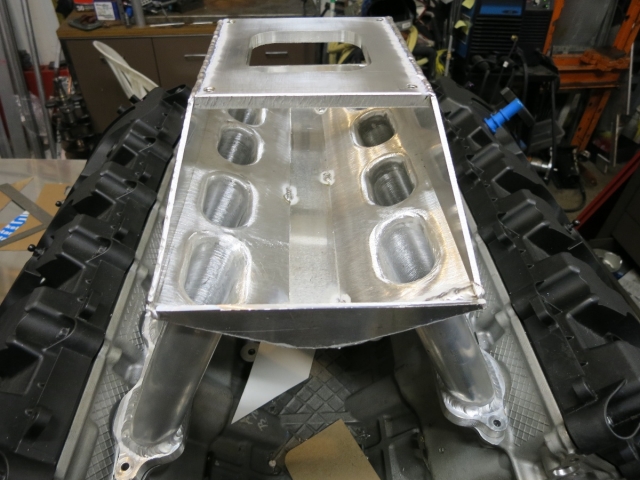
The runner entry points were kept flush to aid the air/fuel entry point into the runner. Using a bellmouth in this instance could have caused fuel suspension issues.
Another possible concern is the large surface area inside the plenum: Would it create issues with the fuel coming out of suspension?
“That’s the main reason I didn’t extend the runners up in the plenum with a bell-mouth entry into each runner – those are ideal for a fuel injected application, but not in this one,” says Groh.
“Everything in a manifold and in an engine is a compromise. If you build the the manifold shorter, then you run into the potential for the low spot of the plenum to catch liquid if the carburetor is not right. If there was a chance for the fuel to fall out of suspension, you’d have the puddling at that low spot with the bell-mouths. That’s not a good idea for a carburetor at all,” he adds.
The runners are tapered from top to bottom to keep the air/fuel mixture velocity up as the airflow enters the cylinder head.
“The runner has a 2.698-inch cross-section at the cylinder head entry point, and the bell entryway is 3.07 inches. It would probably take 15 or 20 manifolds to perfect this down to the last horsepower,” says Groh. “I looked at the factory manifolds – the standard, the BOSS, and the Cobra Jet manifold, but those are fuel injected manifolds, so they just gave me a reference point to work from. Since we’re going a bit backwards on this manifold by using a carburetor, I’ve named it Coyote Ugly. But it’ll work well.”
Stay tuned to the rest of the build as we flush out just what it will take to make this carbureted Coyote bark.



